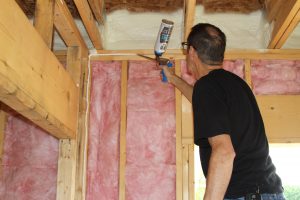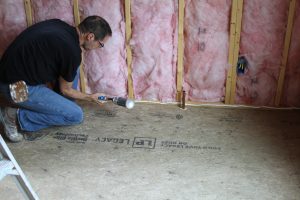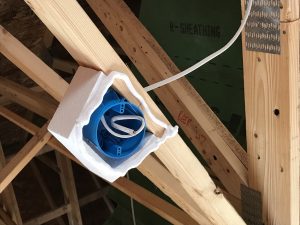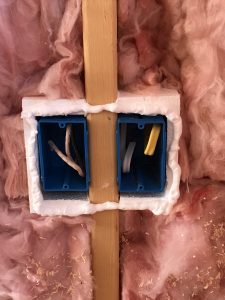Why is building airtight so hard to sell?
By Myron Ferguson
Last week was one of those weeks. I am working on a pretty good size ranch house. We are hanging and taping the drywall and I was also asked to help out with the air sealing because the builder is worried about passing the blower door test for air tightness.
I had walked through with the builder before they insulated and pointed out problem areas and made suggestions on what should be done. The builder did a good job. There were few things that I ended up being contracted to do as well. They wanted me to air seal all penetrations in the drywall and to make the drywall perimeters air tight. We were not putting a vapor retarder on the exterior walls. I was going to use a vapor retarding primer.
This is when I started to notice that a lot of people involved are quite misinformed and as a result spreading misinformation about building airtight.
I had purchased some energy blocks (www.energyblock.com) which is a product I use to isolate electric boxes in the building envelope. I stopped by my lumber yard to pick up some expanding foam and a couple of cases of caulk. I showed them the energy blocks. Keep in mind that I am very enthusiastic about airtightness. I was met with a bunch of people stating with authority that what I was doing is a waste of time because houses have to breath. I explained that the house will breath but we want control of the air exchanges. Someone even said that I was brainwashed. Because this is what they believe I assume they are spreading this misinformation to their customers. We often ask construction question to the people working in lumber yards.
I had subbed out the drywall hanging to a crew that had been hanging drywall for many years. They basically told me the same thing. Houses have to breath and all this airtightness was a waste of time. Are they talking like this on every jobsite? They are pretty good at cutting, fastening, and seam location when hanging drywall but not well informed about building science. How often do they spread this misinformation?
An air exchange system was not specked in the house. The electric, plumbing and HVAC were already installed. I was the first person mentioning an air exchange. The building inspector was confused by the lack of an air exchange system. I was wondering how the job had progressed to this point without this being discussed. The inspector did some research and will approve an exhaust only system as long as switches were installed on the bathroom exhaust fans that can be set to exhaust a predetermined cfm
When the building inspector came to do the insulation inspection I explained that we were not installing a poly vapor retarder on the exterior walls and ceilings. We were instead priming with a vapor retarding primer which he hesitantly approved. The ceilings above the bedrooms were meticulously air sealed and then 20 inches of cellulose blown in. The attic space did not extend to a ridge so the contractor decided to have them as unvented attics. The soffit areas were sealed off with spray foam. The inspector was not sure about this but did approve. He was not happy that we were going to close off the attic access hole but I said we just didn’t want another hole in the ceiling especially into this unvented attic space.
I got along well with the building inspector who I would say was pretty well informed. We talked about a house I did a blower door test on for their CO months ago. They did not even come close to achieving the required ACH 50 of 3.0. Even after I made suggestions (very little of which was done) and as paid to do another test. They have not received their CO and I am not sure what they are going to do. The homeowner was pretty upset with me and the energy code so I doubt I will be back to help out.
I know I am going on and on but I really want to share this last story. Last year a purchased an older house from a bank foreclosure and after fixing it up sold it fairly quickly. I am talking to my daughter who is a realtor about flipping another house. She told me not to waste too much time air sealing and insulating on the next one. The topic never even came up with the buyers and even the home inspector did not say anything positive about all the insulation I put in the attic and how I air sealed and insulated the crawl space and basement walls. He actually made a comment in the report about not being able to see the interior of the basement walls because of the insulation and about poor access to inspect the attic. (I moved the attic access hole to the porch ceiling because I didn’t want the hole in the interior ceiling.
Helping people understand building science is very difficult to us people in the trenches. Sometimes I wonder why I care.




The idea that a house has to breathe comes from the early efforts to tighten up houses, back in the 70’s when oil suddenly got expensive. Sick building syndrome developed in some buildings that were built super tight but without ventilation. In the US, builders were told to not build tight envelopes because buildings “have to breathe”. The Canadian government developed the balanced ventilation system now known as a Heat Recovery Ventilator (HRV). The Canadians then upped the air sealing methods while promoting balanced ventilation. In the US, the Energy Star program was developed and promoted, but the idea that a building had to leak enough to breathe, was very hard to overcome, and most builders still avoid Energy Star.
I like to use evolution to explain air sealing and balanced ventilation, often referred to as “built tight and ventilate right”. Worms and insects breathe through their skin, but life advanced and mammals all breathe using lungs. An airtight building with a balanced ventilation system is the evolutionary equivalent. A building that breathes through its skin also provides pathways for insects, while moving moisture into the interstitial spaces where it breeds mold.
About half of hte heating load of a building in the north is from infiltration. Peeling paint, rotten wood, and nail pops are all caused by air leaks in the building envelope because air flow is how most moisture moves through a buildings exterior walls. Dust mites need the liquid water that winter infiltration causes to form at the leakage site to breed. The easiest way to reduce asthma triggers is to build a tight house and install balanced ventilation.
Interestingly, it is mostly homeowners who listen to me. Most builders do not want to learn anything new.
Well said. Thank You